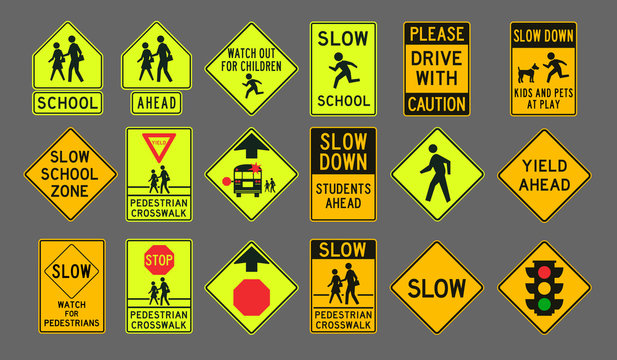Introduction
School zone signs are crucial for ensuring the safety of students and regulating traffic around educational institutions. This article delves into the various aspects of school zone signs, from their types and purposes to their impact on traffic and legal requirements.
What Are School Zone Signs?
School zone signs are traffic signs designed to alert drivers to the presence of a school zone, where children are likely to be present. These signs serve as reminders to drivers to slow down and exercise caution. Common types of school zone signs include speed limit signs, crosswalk signs, and signs indicating school bus stops.
Types of School Zone Signs
- Speed Limit Signs: These signs indicate reduced speed limits within the school zone, usually ranging from 15 to 25 mph.
- Crosswalk Signs: Placed near pedestrian crossings to alert drivers to the presence of children crossing the street.
- School Bus Stop Signs: Indicate areas where school buses pick up or drop off students.
- Flashing Light Signs: Equipped with flashing lights to draw extra attention during school hours or when children are present.
Purpose of School Zone Signs
The primary purpose of school zone signs is to ensure the safety of students. By regulating traffic speed and providing clear warnings to drivers, these signs help create a safer environment for children walking or biking to school. Additionally, they aid in preventing accidents and ensuring smooth traffic flow around school areas.
Design and Features
School zone signs typically feature bright colors, such as fluorescent yellow-green, to enhance visibility. They are often rectangular or diamond-shaped and made with reflective materials to ensure they are easily seen both day and night. Some signs are equipped with flashing lights to further capture drivers’ attention.
Placement and Installation
Proper placement of school zone signs is critical for their effectiveness. They are usually installed at the entrances and exits of school zones, near crosswalks, and at school bus stops. Guidelines for installation include ensuring the signs are visible from a distance and not obstructed by trees or other objects.
Legal Requirements
Federal and state regulations govern the placement and specifications of school zone signs. These regulations mandate specific sizes, colors, and placements to ensure consistency and effectiveness. Penalties for non-compliance, such as failing to adhere to reduced speed limits in school zones, can include fines and points on a driver’s license.
Impact on Traffic
School zone signs play a significant role in slowing down traffic and reducing the likelihood of accidents. Studies have shown that well-placed school zone signs, coupled with strict enforcement, lead to a decrease in speeding and an increase in driver awareness, ultimately enhancing student safety.
Technological Innovations
Advancements in technology have led to the development of solar-powered and digital school zone signs. Solar-powered signs are energy-efficient and can be installed in areas without easy access to electricity. Digital signs can display variable speed limits and other information, adapting to different times of the day or varying traffic conditions.
Community Involvement
Schools, parents, and local authorities play a vital role in the implementation and maintenance of school zone signs. Community involvement includes advocating for the installation of signs, participating in safety awareness programs, and collaborating with local governments to ensure the signs are well-maintained and effective.
Challenges and Solutions
Challenges such as vandalism, damage, and funding can hinder the effectiveness of school zone signs. Solutions include using durable materials, implementing regular maintenance schedules, and seeking funding through grants and community programs to ensure the signs remain functional and visible.
Case Studies
Several regions have successfully implemented school zone sign programs, resulting in enhanced safety and reduced accidents. For instance, a city in California saw a significant decrease in school zone accidents after upgrading to digital flashing light signs and increasing community awareness campaigns.
How to Advocate for More School Zone Signs
Advocating for additional school zone signs in your community involves several steps. Start by identifying areas that lack proper signage, gathering support from parents and local residents, and presenting your case to local authorities. Emphasize the importance of these signs in ensuring student safety and reducing traffic-related incidents.
Future Trends
The future of school zone signs includes the integration of more advanced technologies, such as real-time traffic monitoring and adaptive signal control. These innovations will further enhance the effectiveness of school zone signs and ensure they continue to play a crucial role in student safety.
Conclusion
School zone signs are an essential component of traffic safety around educational institutions. By understanding their types, purposes, and the regulations governing them, communities can work together to ensure these signs are effectively implemented and maintained. The safety of students depends on our collective efforts to advocate for and support the use of school zone signs.
FAQs
Why are school zone signs important? School zone signs are important because they help protect students by alerting drivers to slow down and be cautious in areas where children are likely to be present.
How can I request a school zone sign in my area? To request a school zone sign, contact your local government or transportation department. Provide details about the location and reasons why the sign is needed.
What are the penalties for speeding in a school zone? Penalties for speeding in a school zone can include fines, points on your driver’s license, and increased insurance premiums. The specific penalties vary by state.
How do smart school zone signs work? Smart school zone signs use digital displays and sensors to provide real-time information to drivers, such as current speed limits and alerts when children are present.
Are there any grants available for installing school zone signs? Yes, there are grants and funding programs available from federal, state, and local governments, as well as private organizations, to help communities install and maintain school zone signs.



